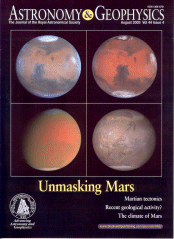|

National Astronomy Week 20032003 August 23rd - 30thProfessor Sir Arnold Wolfendale (14th Astronomer Royal) Professor Sir Martin Rees (15th Astronomer Royal) Professor John Brown (Astronomer Royal for Scotland)
Mars is getting closer! Read the latest National Astronomy Week Press Release More Mars facts can be obtained through the Royal Astronomical Society's recent press release. The National Astronomy Week committee has planned another Week, to be held during August 2003. The years astronomical events, include:
Why that week?The timing of the Week is set to reflect the closest approach, when public interest will be at its highest. Mars will rise about 9.00 pm BST and will be high enough to observe reasonably well by about 10.30, at about 11° altitude. This may not be the ideal time to observe it, as it will mean a late night for many people, and it will be higher in the sky later in the year, but this is the time most people will want to see it and the media attention will be at its peak.The committee considered other weeks, and making the Week itself begin on the Wednesday, but the overwhelming interest in observing Mars swung the balance. The enormous media excitement surrounding the 2001 close approach confirmed this view. We will be learning from that event to try to make sure that accurate information about the visibility of Mars is distributed. Although Mars is the only planet readily visible during the week, it is a new Moon period so deep-sky observing will be possible. What happens during NAW?The aim of the Week is to raise the profile of astronomy and space within the UK. It gives the opportunity for astronomy and space organisations throughout the country to combine in providing special events and observing sessions, using the publicity provided by the NAW organisation. An A4 double-sided POSTER is available for display and provides useful information about Mars.To coincide with the beginning of National Astronomy Week, there will be an All Night Star Party, live TV extravaganza from the Open University and the BBC. This will be broadcast on BBC 2 on the 23rd August at 11.20pm from Jodrell Bank Radio Observatory and La Palma in the Canary Islands. Some of Britain's largest telescopes will be handed over to viewers who can see for themselves the full splendour and violence to be found in the Universe - live and as it happens. Amateur astronomers will also be challenged to find a hitherto unknown asteroid while the programme is on the air. Further details about the programme and its themes will be available from the All Night Star Party Website, which will be live from mid-August. Night Blight! Do you want to see darker skies? The Campaign to Protect Rural England (CPRE) produce publications concerning light pollution. Visit the CPRE Website to see their Night Blight campaign and request copies of their publications. Special Offers!
SPECIAL 20% DISCOUNT ON ASTRONOMY AND SPACE SCIENCE BOOKS FROM
SPRINGER What else is there? For some more amazing facts about Mars you can visit Heather Couper's Website (not an NAW site). Or why not have a look at some planetary images from the Hubble Space Telescope (not an NAW site). NASA makes these pictures freely available for download from their Website and it is likely that a new photograph of Mars will be released within the next few weeks. Robin Scagell of the Society for Popular Astronomy (SPA) has produced an excellent series of postcards for sale that would make a good souvenir of the week as well as an astronomy keepsake. Click here for further details. If you are interested in buying a T-shirt to mark the occasion, click here to see the designs produced by Skymania (this is not an NAW Site). The committee for the Week consists of: Pam Spence (Chairman) – Federation of Astronomical Societies Sandra Voss (Co-ordinator) - Observatory Science Centre Herstmonceux Tel: 01323 831972
John Becklake – Observatory
Science Centre, Herstmonceux:
|

 The August 2003 issue of the
The August 2003 issue of the